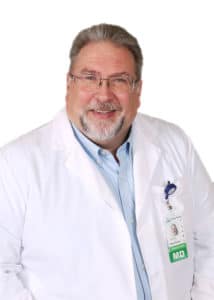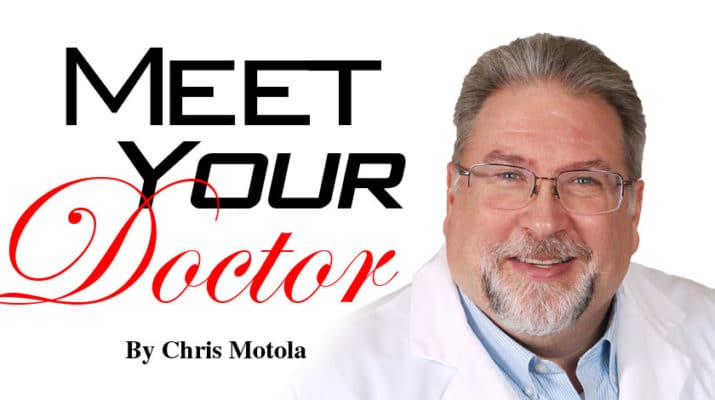New chief medical officer at Oswego Health wants to increase awareness of services, surgeries offered locally and to build a culture of safety
By Chris Motola

Q: How did you come to be medical director at Oswego Health?
A: I came from a small, critical access hospital in central Pennsylvania where I was mostly doing endoscopies. We decided, my wife and I, that if I was ever going to get back into being a general surgeon, we needed to start looking for new positions. And as we were looking, Oswego popped up on our radar.
Q: What did you find appealing about Oswego Health?
A: I was working for a small hospital that got taken over by a large behemoth and was definitely starting to feel a little bit of the headaches of the larger health system. We came up, we interviewed, we checked out the place. It appeared to be somewhere my skills as a surgeon could be offered to the community to help expand the services that are here, as well as help me do more of what I was trained to do.
Q: What are your plans as CMO?
A: We are trying to reinforce the services we offer here, including general surgery, colorectal surgery, bariatric surgery, breast surgery, orthopedic surgery, urology. And of course we do a lot of endoscopies. We are even trying to rope in the services of abdominoplasty surgery – Jude LaBarbera MD. We’re trying to expand all of that while at the same time focusing on patient safety and building a culture of safety at Oswego Health.
Q: For a rural hospital, Oswego Health does quite a few surgeries — more than 6,000 in 2018. Is that a well-known fact? Is that something the hospital wants to be known for more?
A: I think one of the issues is people don’t realize the services we can offer them right here at home. We have the ability to do joints, total hips, most general surgery. We have a full complement of services available that people may not understand or recognize are here. We’re trying to get that information out so that people know what we’re capable of.
Q: What’s the scope of those services?
A: Most any non-subspecialty service is available here. If you’re talking about open-heart surgery, lung surgery, spinal surgery, those are things you’d go to a tertiary care facility for, but just using general surgery as an example, gall bladder, colon lesions, hernias, [non-cosmetic] breast surgery. These are all things we can easily do here, do with more convenience for the patient and get outcomes that are comparable if not better than at a larger facility.
Q: What factors play into that?
A: Our patient satisfaction scores are usually much higher than the larger facilities because we have more of a hometown feel than a big university feel. We monitor our infection rates carefully, we monitor our return admissions; we keep records of everything. And because we’re a smaller facility, we’re able to keep a closer handle on it than some of the larger places.
Q: You mentioned wanting to get back into general surgery. To what degree have you been able to retain your practice while in an administrative role?
A: My administrative role is basically about a third of my duties now. Realistically, it expands beyond that, but schedule-wise it’s taking about a third of my time. The rest of the time I’m doing after hours, I’m doing after hours, weekends, etc. But I maintain a full general surgery practice. I operate on Mondays and Fridays. I have office hours on Tuesday and Thursdays. My administrative day is Wednesday.
Q: Does being involved in care give you a better sense of how to respond administratively?
A: Oh, definitely. It gives me a better handle on the functioning of the facility and what changes we can make for the betterment of the facility.
Q: You’re a general surgeon, but do you have any procedures you would say you informally specialize in?
A: I would consider my specialty to be minimally invasive surgery. About 95% of my hernias I do laparoscopically. I do gall bladders laparoscopically. I do most everything with minimally invasive techniques.
Q: How much does Oswego County’s infamous winter weather play into Oswego Health’s service strategies?
A: We’re not a critical access environment, but we definitely offer services that would be difficult to obtain during the winter if we weren’t here.
Q: For surgery sites, are we talking about the main campus, or satellites as well?
A: At the moment our surgeries are done at the main hospital. The second floor is our main operating area with a separate entrance for same-day surgeries. We would eventually like to work toward an outpatient surgery center, but that’s in our future, not our present.
Q: Are you partnered with any of the big hospitals in the region?
A: We have multiple affiliations with other facilities in Syracuse. Nothing is at the partnership level, but we work with surgeons at Crouse for bariatric surgery. We work with radiology at Crouse. We work with cardiology from St. Joe’s. We have cancer services through Upstate. So we basically have affiliations with all of the major hospitals in Syracuse.
Q: How do your wait times compare to bigger hospitals?
A: We’re quite proud of the fact that we can get people to be seen within 24 to 48 hours. If needed, we can get them into the operating room within a week, or the following week. In general my experience with larger facilities, it’s weeks not days to be seen.
Lifelines
Name: Duane F. Tull, M.D.
Position: Chief medical officer at Oswego Health
Hometown: Salisbury, Maryland
Education: Eastern Virginia Medical School; Hampden-Sydney College
Affiliations: Oswego Health
Organizations: American Board of Surgery; American College of Surgeons
Family: Wife
Hobbies: Fishing, outdoor activities, cars

